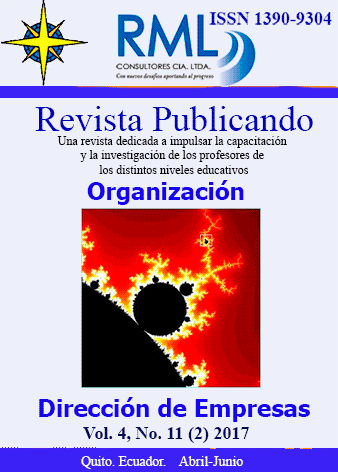Abstract
Las empresas relacionadas con el medio ambiente seguirán creciendo como una industria prometedora de acuerdo con las estimaciones globales. Existe un paralelo entre la capacidad de los ecosistemas y el desarrollo de sociedades y actividades productivas humanas en el que se soporta nuestro estilo de vida.
La presente contribución tiene como propósito destacar las principales tendencias en estrategias administrativas en negocios de gestión ambiental. Para lograr esto, se desarrolla la investigación a través de una revisión bibliográfica empleando las potencialidades de gestión bibliometricas y documentales del directorio internacional Scopus. Los resultados destacan tres línea o estrategias administrativas en negocios de gestión ambiental, fundamentales: La eficiencia y seguridad en el manejo de residuos fabriles optimizando económicamente estos procesos mediante la implantación de tecnologías robóticas; El control del almacenamiento de los residuos industriales mediante procesos químicos, físicos y estrategias organizativas computarizadas, que garantizan ventajas financieras dentro de las condiciones legislativas y ecológicas. Y, por último, la clasificación de los residuos fabriles o industriales mediante métodos estructurados en condiciones fisicoquímicas e incidencia medioambiental, que garantice ventajas económicas a través de los distintos procesos de reciclaje, en donde sea posible.
References
de Vries, R. E., Pathak, R. D., van Gelder, J. L., & Singh, G. (2017). Explaining Unethical Business Decisions: The role of personality, environment, and states. Personality and Individual Differences, 117, 188-197. doi:10.1016/j.paid.2017.06.007
Donato, D. B., Madden-Hallett, D. M., Smith, G. B., & Gursansky, W. (2017). Heap leach cyanide irrigation and risk to wildlife: Ramifications for the international cyanide management code. Ecotoxicology and Environmental Safety, 140, 271-278. doi:http://dx.doi.org/10.1016/j.ecoenv.2017.02.033
Earnhart, D., & Leonard, J. M. (2013). Determinants of environmental audit frequency: The role of firm organizational structure. Journal of Environmental Management, 128, 497-513. doi:http://dx.doi.org/10.1016/j.jenvman.2013.05.042
Ehdaie, B., Assel, M., Benfante, N., Malhotra, D., & Vickers, A. (2017). A Systematic Approach to Discussing Active Surveillance with Patients with Low-risk Prostate Cancer. European Urology. doi:10.1016/j.eururo.2016.12.026
Erragragui, E. (2017). Do creditors price firms”™ environmental, social and governance risks? Research in International Business and Finance. doi:http://dx.doi.org/10.1016/j.ribaf.2017.07.151
Hansen, M. W., Langevang, T., Rutashobya, L., & Urassa, G. (2017). Coping with the African Business Environment: Enterprise Strategy in Response to Institutional Uncertainty in Tanzania. Journal of African Business, 1-26. doi:10.1080/15228916.2017.1330028
Hellwig, M. F. (2009). Systemic risk in the financial sector: An analysis of the subprime-mortgage financial crisis. De economist, 157(2), 129-207.
Ji-fan Ren, S., Fosso Wamba, S., Akter, S., Dubey, R., & Childe, S. J. (2017). Modelling quality dynamics, business value and firm performance in a big data analytics environment. International Journal of Production Research, 55(17), 5011-5026. doi:10.1080/00207543.2016.1154209
Komljenovic, D., Loiselle, G., & Kumral, M. (2017). Organization: A new focus on mine safety improvement in a complex operational and business environment. International Journal of Mining Science and Technology, 27(4), 617-625. doi:10.1016/j.ijmst.2017.05.006
Kurosaka, S. (2005). New Trend of Corporate Strategies of Waste Management Business. Paper presented at the Environmentally Conscious Design and Inverse Manufacturing, 2005. Eco Design 2005. Fourth International Symposium on.
Mickiewicz, T., Rebmann, A., & Sauka, A. (2017). To Pay or Not to Pay? Business Owners”™ Tax Morale: Testing a Neo-Institutional Framework in a Transition Environment. Journal of Business Ethics, 1-19. doi:10.1007/s10551-017-3623-2
Mohan Das Gandhi, N., Selladurai, V., & Santhi, P. (2006). Green productivity indexing: a practical step towards integrating environmental protection into corporate performance. International Journal of Productivity and Performance Management, 55(7), 594-606.
Nagasawa, S. (2002). Environment friendly business society.
Penini, G., & Carmeli, A. (2010). Auditing in organizations: A theoretical concept and empirical evidence. Systems Research and Behavioral Science, 27(1), 37-59.
Rialp-Criado, A., & Komochkova, K. (2017). Innovation strategy and export intensity of Chinese SMEs: The moderating role of the home-country business environment. Asian Business and Management, 16(3), 158-186. doi:10.1057/s41291-017-0018-2
Springett, D. (2003). Business conceptions of sustainable development: A perspective from critical theory. Business Strategy and the Environment, 12(2), 71-86.
Stone, L. J. (2006). Limitations of cleaner production programmes as organisational change agents. II. Leadership, support, communication, involvement and programme design. Journal of Cleaner Production, 14(1), 15-30.
Um, J. (2017). The impact of supply chain agility on business performance in a high level customization environment. Operations Management Research, 10(1-2), 10-19. doi:10.1007/s12063-016-0120-1
Viegas, C. V., Bond, A., Duarte Ribeiro, J. L., & Selig, P. M. (2013). A review of environmental monitoring and auditing in the context of risk: unveiling the extent of a confused relationship. Journal of Cleaner Production, 47, 165-173. doi:http://dx.doi.org/10.1016/j.jclepro.2012.12.041
Wu, Y., Feng, G., & Fung, R. Y. K. (2017). Comparison of information security decisions under different security and business environments. Journal of the Operational Research Society, 1-15. doi:10.1057/s41274-017-0263-y
You are free to:
Share — copy and redistribute the material in any medium or format.
Adapt — remix, transform, and build upon the material.
The licensor cannot revoke these freedoms as long as you follow the license terms.
Under the following terms:
Attribution — You must give appropriate credit, provide a link to the license, and indicate if changes were made. You may do so in any reasonable manner, but not in any way that suggests the licensor endorses you or your use.
NonCommercial — You may not use the material for commercial purposes.
ShareAlike — If you remix, transform, or build upon the material, you must distribute your contributions under the same license as the original.
No additional restrictions — You may not apply legal terms or technological measures that legally restrict others from doing anything the license permits.
